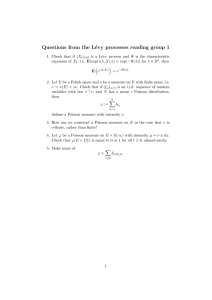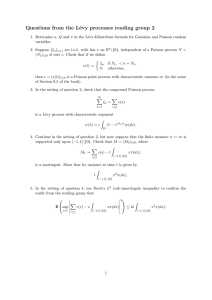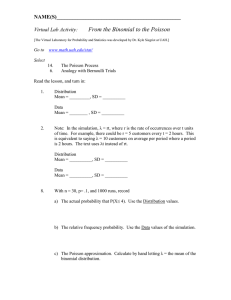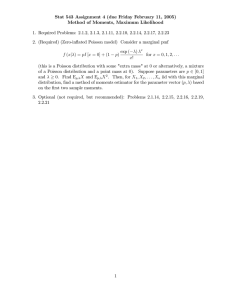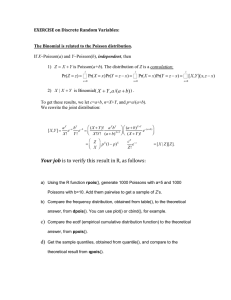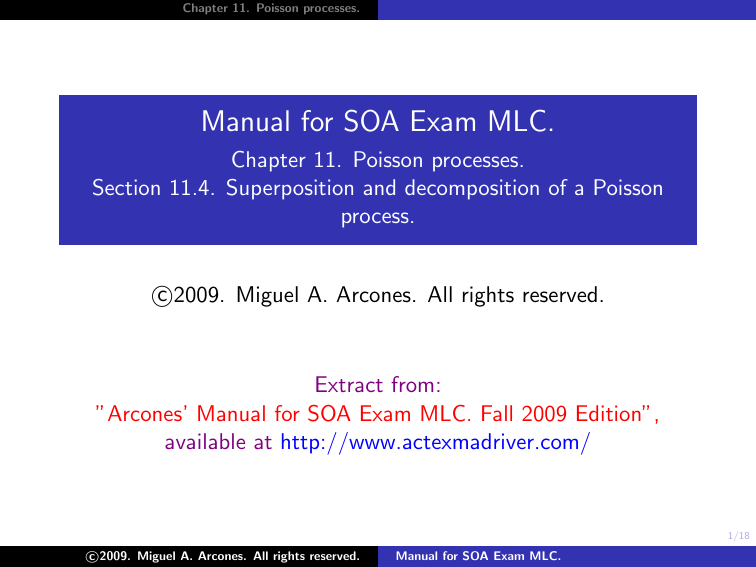
Chapter 11. Poisson processes.
Manual for SOA Exam MLC.
Chapter 11. Poisson processes.
Section 11.4. Superposition and decomposition of a Poisson
process.
c
2009.
Miguel A. Arcones. All rights reserved.
Extract from:
”Arcones’ Manual for SOA Exam MLC. Fall 2009 Edition”,
available at http://www.actexmadriver.com/
1/18
c
2009.
Miguel A. Arcones. All rights reserved.
Manual for SOA Exam MLC.
Chapter 11. Poisson processes.
Section 11.4. Superposition and decomposition of a Poisson proc
Superposition and decomposition of a Poisson process
We know that:
Theorem 1
Let X ∼ Poisson(λ1 ) and Y ∼ Poisson(λ2 ). Suppose that X and
Y are independent. Then, X + Y ∼ Poisson(λ1 + λ2 ).
Next theorem generalizes previous theorem to Poisson processes.
Theorem 2
If {N1 (t) : t ≥ 0} and {N2 (t) : t ≥ 0} are two independent
Poisson processes with respective rates λ1 and λ2 . Then,
{N1 (t) + N2 (t) : t ≥ 0} is a Poisson process with rate λ1 + λ2 .
The Poisson process {N1 (t) + N2 (t) : t ≥ 0} is called the
superposition of {N1 (t) : t ≥ 0} and {N2 (t) : t ≥ 0}.
2/18
c
2009.
Miguel A. Arcones. All rights reserved.
Manual for SOA Exam MLC.
Chapter 11. Poisson processes.
Section 11.4. Superposition and decomposition of a Poisson proc
Proof.
Let N(t) = N1 (t) + N2 (t). Given 0 ≤ t1 < t2 < · · · < tm ,
N1 (t1 ), N1 (t2 ) − N1 (t1 ), . . . , N1 (tm ) − N1 (tm−1 ),
N2 (t1 ), N2 (t2 ) − N1 (t1 ), . . . , N2 (tm ) − N1 (tm−1 )
are independent r.v.’s. So,
N(t1 ), N(t2 ) − N(t1 ), . . . , N(tm ) − N(tm−1 )
are independent r.v.’s. Besides,
N1 (tj ) − N1 (tj−1 ) ∼ Poisson(λ1 (tj − tj−1 )) and
N2 (tj ) − N2 (tj−1 ) ∼ Poisson(λ2 (tj − tj−1 )). So,
N(tj ) − N(tj−1 ) ∼ Poisson((λ1 + λ2 )(tj − tj−1 )). Hence,
{N(t) : t ≥ 0} is a Poisson processes with rate λ1 + λ2 .
3/18
c
2009.
Miguel A. Arcones. All rights reserved.
Manual for SOA Exam MLC.
Chapter 11. Poisson processes.
Section 11.4. Superposition and decomposition of a Poisson proc
Example 1
An insurance company receives two type of claims: car and home.
The number of car insurance claims received follows a Poisson
process distribution with rate 20 claims per day. The number of
home insurance claims received follows a Poisson process
distribution with rate 5 claims per day. Both processes are
independent. Estimate the probability that this insurance company
receives more than a 800 claims in a 30 day period.
4/18
c
2009.
Miguel A. Arcones. All rights reserved.
Manual for SOA Exam MLC.
Chapter 11. Poisson processes.
Section 11.4. Superposition and decomposition of a Poisson proc
Example 1
An insurance company receives two type of claims: car and home.
The number of car insurance claims received follows a Poisson
process distribution with rate 20 claims per day. The number of
home insurance claims received follows a Poisson process
distribution with rate 5 claims per day. Both processes are
independent. Estimate the probability that this insurance company
receives more than a 800 claims in a 30 day period.
Solution: The number of claims received until time t follows a
Poisson process with rate 25 claims per day. We have that
E [N(30)] = (30)(25) = 750, Var(N(30)) = (30)(25) = 750
800.5 − 750
√
and P{N(30) > 800} ≈ P N(0, 1) >
750
≈P{N(0, 1) > 1.84} = 0.0329.
5/18
c
2009.
Miguel A. Arcones. All rights reserved.
Manual for SOA Exam MLC.
Chapter 11. Poisson processes.
Section 11.4. Superposition and decomposition of a Poisson proc
Theorem 3
Let {N1 (t) : t ≥ 0} and {N2 (t) : t ≥ 0} be two independent
Poisson processes with respective rates λ1 and λ2 . Let
N(t) = N1 (t) + N2 (t), t ≥ 0. Let λ = λ1 + λ2 . Then, the
conditional distribution of N1 (t) given N(t) = n is binomial with
parameters n and p = λλ1 .
6/18
c
2009.
Miguel A. Arcones. All rights reserved.
Manual for SOA Exam MLC.
Chapter 11. Poisson processes.
Section 11.4. Superposition and decomposition of a Poisson proc
Theorem 3
Let {N1 (t) : t ≥ 0} and {N2 (t) : t ≥ 0} be two independent
Poisson processes with respective rates λ1 and λ2 . Let
N(t) = N1 (t) + N2 (t), t ≥ 0. Let λ = λ1 + λ2 . Then, the
conditional distribution of N1 (t) given N(t) = n is binomial with
parameters n and p = λλ1 .
The previous theorem states that given that the total number of
occurrences is n, the probability that a given occurrence is of type
1 is λλ1 independently of the rest of the occurrences.
7/18
c
2009.
Miguel A. Arcones. All rights reserved.
Manual for SOA Exam MLC.
Chapter 11. Poisson processes.
Section 11.4. Superposition and decomposition of a Poisson proc
Theorem 3
Let {N1 (t) : t ≥ 0} and {N2 (t) : t ≥ 0} be two independent
Poisson processes with respective rates λ1 and λ2 . Let
N(t) = N1 (t) + N2 (t), t ≥ 0. Let λ = λ1 + λ2 . Then, the
conditional distribution of N1 (t) given N(t) = n is binomial with
parameters n and p = λλ1 .
The previous theorem states that given that the total number of
occurrences is n, the probability that a given occurrence is of type
1 is λλ1 independently of the rest of the occurrences.
Proof.
We have that
P{N1 (t) = k|N(t) = n} =
=
e −λ1 t (λ1 t)k e −λ2 t (λ2 t)n−k
·
k!
(n−k)!
e −λt (λt)n
n!
=
P{N1 (t)=k, N(t)=n}
P{N(t)=n}
n
k
=
P{N1 (t)=k, N2 (t)=n−k}
P{N(t)=n}
p k (1 − p)n−k .
8/18
c
2009.
Miguel A. Arcones. All rights reserved.
Manual for SOA Exam MLC.
Chapter 11. Poisson processes.
Section 11.4. Superposition and decomposition of a Poisson proc
Example 2
An insurance company receives two type of claims: car and home.
The number of car insurance claims received follows a Poisson
process distribution with rate 20 claims per day. The number of
home insurance claims received follows a Poisson process
distribution with rate 5 claims per day. Both processes are
independent. Suppose that in a given day five claims are received.
Calculate the probability that exactly three claims are car insurance
claims.
9/18
c
2009.
Miguel A. Arcones. All rights reserved.
Manual for SOA Exam MLC.
Chapter 11. Poisson processes.
Section 11.4. Superposition and decomposition of a Poisson proc
Example 2
An insurance company receives two type of claims: car and home.
The number of car insurance claims received follows a Poisson
process distribution with rate 20 claims per day. The number of
home insurance claims received follows a Poisson process
distribution with rate 5 claims per day. Both processes are
independent. Suppose that in a given day five claims are received.
Calculate the probability that exactly three claims are car insurance
claims.
Solution: Let X be the number of claims which are are car
insurance claims. X has a binomial distribution with n = 5 and
20
p = 20+5
= 45 . Hence,
3 2
1
5
4
= 0.2048.
P[X = 3} =
5
5
3
10/18
c
2009.
Miguel A. Arcones. All rights reserved.
Manual for SOA Exam MLC.
Chapter 11. Poisson processes.
Section 11.4. Superposition and decomposition of a Poisson proc
Decomposition of a Poisson process.
Consider a Poisson process {N(t) : t ≥ 0} with rate λ. Suppose
that each time an event occurs it is classified as either a type I or a
type II event. Suppose further that each event is classified as type
I event with probability p and as type II event with probability
1 − p. Let N1 (t) denote respectively the number of type I events
occurring in [0, t]. Let N2 (t) denote respectively the number of
type II events occurring in [0, t]. Note that N(t) = N1 (t) + N2 (t).
Theorem 4
{N1 (t) : t ≥ 0} and {N2 (t) : t ≥ 0} are independent Poisson
processes with respective rates λ1 = λp and λ2 = λ(1 − p).
Proof: See Arcones’ manual.
11/18
c
2009.
Miguel A. Arcones. All rights reserved.
Manual for SOA Exam MLC.
Chapter 11. Poisson processes.
Section 11.4. Superposition and decomposition of a Poisson proc
Example 3
Customers arrive to a store according with a Poisson process with
rate λ = 20 arrivals per hour. Suppose that the probability that a
customer buys something is p = 0.30.
12/18
c
2009.
Miguel A. Arcones. All rights reserved.
Manual for SOA Exam MLC.
Chapter 11. Poisson processes.
Section 11.4. Superposition and decomposition of a Poisson proc
Example 3
Customers arrive to a store according with a Poisson process with
rate λ = 20 arrivals per hour. Suppose that the probability that a
customer buys something is p = 0.30.
(i) Find the expected number of sales made during an eight-hour
business day.
Solution: (i) Let N1 (t) be the number of arrivals who buy something. Let N2 (t) be the number of arrivals who do not buy something. N1 and N2 are two independent Poisson processes. The rate
for N1 is λ1 = λp = (20)(0.3) = 6. Hence, E [N1 (8)] = (8)(6) = 48.
13/18
c
2009.
Miguel A. Arcones. All rights reserved.
Manual for SOA Exam MLC.
Chapter 11. Poisson processes.
Section 11.4. Superposition and decomposition of a Poisson proc
Example 3
Customers arrive to a store according with a Poisson process with
rate λ = 20 arrivals per hour. Suppose that the probability that a
customer buys something is p = 0.30.
(ii) Find the probability that 10 or more sales are made in a period
of one hour.
P
Solution: (ii) P{N1 (1) ≥ 10} = 1 − 9j=0 P{N1 (1) = j} = 1 −
P9 e −6 6j
j=0 j! = 0.04262092358.
14/18
c
2009.
Miguel A. Arcones. All rights reserved.
Manual for SOA Exam MLC.
Chapter 11. Poisson processes.
Section 11.4. Superposition and decomposition of a Poisson proc
Example 3
Customers arrive to a store according with a Poisson process with
rate λ = 20 arrivals per hour. Suppose that the probability that a
customer buys something is p = 0.30.
(iii) The store opens at 8 a.m. find the expected time of the tenth
sale of the day.
Solution: (iii) Let S10,1 be the time of the tenth sale of the day.
Then, E [S10,1 ] = (10) λ11 = 10
6 hours or 100 minutes. The expected
time of the tenth sale is 9 : 40 a.m.
15/18
c
2009.
Miguel A. Arcones. All rights reserved.
Manual for SOA Exam MLC.
Chapter 11. Poisson processes.
Section 11.4. Superposition and decomposition of a Poisson proc
Consider two independent Poisson processes {N1 (t) : t ≥ 0} and
{N2 (t) : t ≥ 0} with respective rates λ1 and λ2 . Let S1,n be the
time of the n–th arrival for the first Poisson process. Let S2,m be
the time of the m–th arrival for the second Poisson process.
Suppose that S1,n < S2,m , then at the time of the n + m − 1–th
arrival for both Poisson processes, we have observed n or more
arrivals of the first Poisson process. Hence,
P{S1,n < S2,m }
n+m−1
X n + m − 1 λ1 k λ2 n+m−1−k
.
=
k
λ1 + λ2
λ1 + λ 2
k=n
16/18
c
2009.
Miguel A. Arcones. All rights reserved.
Manual for SOA Exam MLC.
Chapter 11. Poisson processes.
Section 11.4. Superposition and decomposition of a Poisson proc
Example 4
An insurance company receives two type of claims: car and home.
The number of car insurance claims received follows a Poisson
process distribution with rate 20 claims per day. The number of
home insurance claims received follows a Poisson process
distribution with rate 5 claims per day. Both processes are
independent. Calculate the probability that at least two car
insurance claims arrive before three home insurance claims arrive.
17/18
c
2009.
Miguel A. Arcones. All rights reserved.
Manual for SOA Exam MLC.
Chapter 11. Poisson processes.
Section 11.4. Superposition and decomposition of a Poisson proc
Example 4
An insurance company receives two type of claims: car and home.
The number of car insurance claims received follows a Poisson
process distribution with rate 20 claims per day. The number of
home insurance claims received follows a Poisson process
distribution with rate 5 claims per day. Both processes are
independent. Calculate the probability that at least two car
insurance claims arrive before three home insurance claims arrive.
Solution: The probability that a claim is a car insurance is
20
4
20+5 = 5 . When at least two car insurance claims arrive before
three home insurance claims arrive, we have that form the first
fours claims, we get two or more car insurance claims. Hence, the
answer is
2 2 3 1 4 0
4
4
1
4
4
1
4
4
1
+
+
2
5
5
3
5
5
4
5
5
=0.1536 + 0.4096 + 0.4096 = 0.9728.
18/18
c
2009.
Miguel A. Arcones. All rights reserved.
Manual for SOA Exam MLC.

